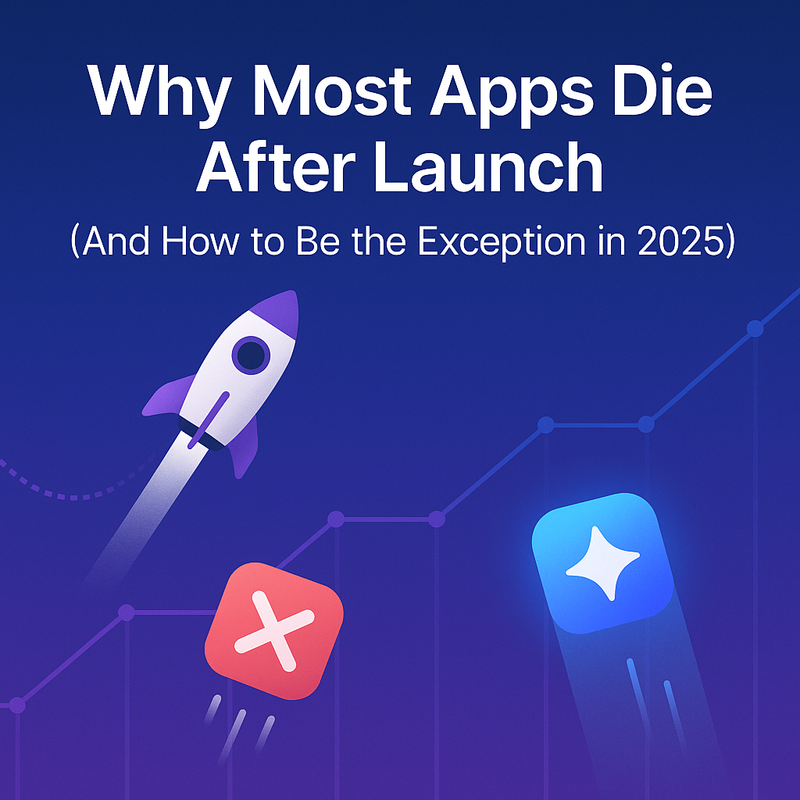Why Most Apps Die After Launch (And How to Be the Exception in 2025)

Why Most Apps Die After Launch (And How to Be the Exception in 2025)

Launching an app is easy. Keeping it alive is where 90% fail. This guide reveals why most apps vanish post-launch and gives you an actionable blueprint to break into the top 10% that thrive — with real strategies founders are using in 2025.
🧠 Introduction
Launching your app is a rush. That first upvote, first sign-up, first piece of feedback — it’s exhilarating. But then... silence. No installs. No retention. No growth.
Here’s the truth:
Launching is just day one.
What comes next determines if you build a business — or bury a side project.
Let’s break down why most apps fail after launch, and more importantly, how you can be the exception.
🚨 Why Most Apps Fail After Launch
1. They Rely Only on Product Hunt
Yes, Product Hunt gives you visibility. But it’s one day. After that?
- You’re buried under new launches
- You chase more upvotes instead of real traction
- You think launch = success
Solution: Stack your launch across multiple channels — Nazca.my, Reddit, X (Twitter), LinkedIn, YouTube, TikTok, etc.
2. They Don't Know Who Their Users Are
Building for “everyone” = building for no one.
Common signs:
- Vague landing pages
- Features that try to do everything
- No clear messaging
Solution: Build a user persona early. Interview 5–10 users. Test messaging. Focus on solving one painful problem well.
3. They Stop Talking About It
Marketing isn’t a one-time tweet.
After launch, founders go silent — waiting for users instead of earning them.
Solution:
- Share your journey (build in public)
- Document features on social
- Answer questions on Reddit, Quora, Discord
- Run a newsletter even if it’s just 20 people
4. They Don’t Collect Feedback
Some apps don’t fail — they just never evolve.
If you’re not hearing what users want, you’re building blind.
Solution:
- Add in-app feedback prompts
- Email new users with 3 questions
- Join your own community (yes, seriously)
5. They Don't Have a Post-Launch Plan
Launching is exciting. But what happens on day 2?
No content. No follow-up emails. No growth systems.
Solution: Create a 30-day post-launch checklist:
- ✅ Email welcome series
- ✅ Weekly content/blogs
- ✅ Social media drip
- ✅ Feature update roadmap
- ✅ Analytics tracking (Mixpanel, PostHog, etc.)
🔑 What Thriving Apps Do Differently
Let’s shift gears. These are what the successful 10% do after launch that the rest don’t.
🚀 1. They Launch Multiple Times
No one remembers your first tweet. Or your first post.
📌 They relaunch:
- On new platforms
- After feature updates
- In different formats (case studies, video demos, threads)
✅ Apps that win create new entry points every month.
🔁 2. They Use Feedback Loops
Good apps guess. Great apps listen.
- Every feature is user-driven
- They share “why we built this”
- They have communities (Slack, Discord, or even Telegram)
Example:
A founder posts on Reddit, gets 20 comments → builds a fix → announces it → users feel heard → retention grows.
🧲 3. They Nail Their Positioning
Compare these two:
- “A tool for productivity”
vs. - “A Notion plugin that auto-generates weekly status updates for remote teams”
👀 Guess which one gets clicks?
Positioning makes your app memorable.
📈 4. They Build SEO Moats Early
Great apps don’t rely only on social.
They:
- Create targeted blog posts
- Rank for long-tail keywords
- Add explainer videos on YouTube
- Submit to alt-directories like Nazca.my
Even if SEO is slow, it compounds like crazy.
💬 5. They Engage in Communities
Where do your users hang out?
- Designers → Twitter + Dribbble
- Devs → Hacker News + Reddit
- Creators → LinkedIn + X + Indie Hackers
🧠 Smart founders show up before pitching.
Engage first. Drop value. Then launch.
💰 6. They Monetize Early (Even $1)
You don’t need thousands of users to make money.
But too many wait too long to charge.
💡 Try:
- Lifetime deals
- Micro-subscriptions
- Notion templates or extras
- $5 early access + community
✅ Real payment = real validation
🧪 7. They Experiment Fast
Winning apps test:
- Pricing
- Onboarding
- Copy
- Features
- Distribution channels
They don’t build in secret. They ship fast, fix faster.
✅ Post-Launch Checklist for 2025
Here’s your go-to Post-Launch Survival Kit:
| Task | Why It Matters |
|---|---|
| Submit to Nazca.my | Boosts app discovery in indie & early adopter circles |
| Write “I launched X” post | Creates story-driven engagement |
| Launch on Reddit, Indie Hackers, LinkedIn | Different audiences = more data |
| Add blog & SEO strategy | Long-term traffic moat |
| Start an email list | Retain users, announce features |
| Ask for feedback on onboarding | Improve retention instantly |
| Release features weekly | Show momentum, re-engage users |
| Track analytics | Know what’s working |
| Relaunch every 30 days | Stay top of mind |
🔥 Tools You Can Use (and Actually Work)
- Nazca.my – App submission + discovery platform
- Beehiiv / Substack – Newsletter
- Tally / Typeform – Collect user feedback
- Notion / Trello – Public roadmap
- Mixpanel / PostHog – Analytics
- Carrd / Framer – One-page websites
- Loom / ScreenStudio – Product demos
- Twitter + LinkedIn – Build distribution
🎯 Final Takeaway
Most apps die not because they’re bad — but because they disappear.
In 2025, visibility is a flywheel:
- Talk about your app often
- Launch everywhere your users live
- Use Nazca.my to stay visible longer
🚀 Build it. Ship it. Then market it like hell.
You got this.
fAdnim
Author at Nazca. Passionate about creating exceptional mobile applications and sharing knowledge with the developer community.
